

|
Back to |
| The Front Page |
| News & Features |

|
The Liverpool Project Phase One: Urban Renewal |
|||||
|
by James Hawkins co-editor, Croquet World Online layout by Reuben Edwards Posted April 28, 2006
|
|
||||
From its pre-eminent position as the key port of the British Empire in the 19th Century, Liverpool has undergone a series of hardships since the 1940s. Synonymous in the UK – though not always fairly – with social deprivation and urban decay, the city is turning itself round. The legacy of Liverpool’s Victorian benefactors has helped it towards the title of European Capital of Culture in 2008. The City Council plans to promote regeneration through leisure – whether it’s ballet, the Beatles or boxing. Liverpool has never had its own croquet club, but James Hawkins, Croquet World’s new co-editor, is keen to ride the wave of the game’s resurgence in his home city. With no lawns, no members and no money, he reports on his first steps towards getting his fellow Liverpudlians playing croquet.
In June 1985, I decided to become a croquet player. I wrote to the Croquet Association, and asked for details of my local club. It turned out that I didn’t have one; I could drive 25 miles north to Southport, 25 miles east to Bowdon or 25 miles south to Chester. Twenty-one years later, the croquet map has filled out and there are many more clubs in the North West of England, but locally the picture’s still pretty much the same – Liverpool remains a croquet desert.
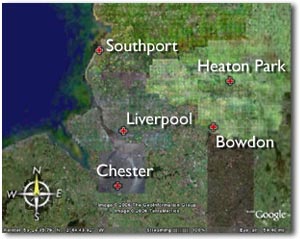
|
| The croquet map shows that the nearest clubs of Chester, Bowdon and Heaton Park (the Commonwealth Games venue and satellite to Bury Croquet Club), each with four lawns, are at least a 40-minute drive from Liverpool. Further to the north are clubs at Southport and Pendle. |
It’s hardly ever bothered me. Those who engage in the pursuit of minority sports accept a commensurate level of inconvenience. My playing activity has always been based on travelling to tournaments, playing league matches away from home, and coaching at remote clubs. I’ve never had a home club, so I don’t miss not having one. But the last few years have seen an increasing interest from outsiders throughout Liverpool – pensioners from staunchly blue-collar Halewood to the southeast, or school kids from run-down Croxteth to the north. Sooner or later, that trickle of interest must swell to a flood, and Liverpool Croquet Club looks like an inevitability.
My first approach
I contacted the Sports Development Department at the City Council in 2004. The response was dispiriting.
Me: “Hello, I’d like to set up a croquet club.”
Five second pause.
Him: “…Well, I suppose, there isn’t really that much provision for your sort.”
My sort? How did he see me? Sat in a bath chair, with a tartan rug over my lap? Or leaping around my oak-panelled library in straw hat and striped blazer? It’s not hard to counter such prejudices, but the political will and meagre finances of local government are harder to overcome.
Sports policy within the city is based on combating child obesity and tackling social deprivation. Efforts are focused on football, swimming, tennis and boxing. Other sports – even cricket, basketball or hockey – fail to get a look-in. Something like croquet, with its middle-class “elitist” tag, is way off the development radar. So the City Council fob me off with a “Sorry, can’t help,” and suggest I try asking a local tennis club for an overgrown corner of their site.

You’ve got to have some sympathy for the Council’s position. They have to draw a line between sports that are marketable by a small team in the Development Department, which will get disadvantaged kids away from delinquency, or bring them out into the fresh air and away from their PlayStations, versus sports – like croquet – that are harder to sell, which appeal to a smaller group, and which don’t (or don’t seem to) fulfil the current greatest-need criteria. Surely, I thought, there’s no way forward for the game in Liverpool.
My mind changed a year ago. I was writing an article for the Croquet Gazette on the rebirth of Pendle Croquet Club. Evicted from their home of 20 years and with no means of financial support, they found a site, raised the cash, created five lawns and a clubhouse from scratch, and are now playing at their new venue. So what am I complaining about? Somehow or other, I must be able to make this happen in Liverpool.
The hunt for a site
Leafy south Liverpool quickly revealed itself as the favoured location for the new club. As the primary residential area, it possesses an endless swathe of public parkland. It occupies the point farthest from each of the neighbouring clubs, so gives the widest, as well as the most promising, catchment for potential members.
I’d ruled out private land (the Cricket Club, various tennis clubs, expensive-to-rent private sports fields) almost immediately. Nothing is surer to kill off a seedling club than to force it to compete for space with a larger, healthier rival. And the eight municipal parks in the area provided plenty of choice for me to find the perfect site - in some ways, too much choice, and it took a long while to whittle down the options.
Top of my initial list was Calderstones Park (not least because it’s two minutes’ walk from my front door). In many ways, it’s the jewel in the city’s crown, with both a formal Japanese garden and an Old English knot garden. There’s a thousand-year old oak tree, and a Bronze Age burial ground (the Calder Stones). It’s constantly seething with sunbathers, footballers, dog-walkers and young families using every inch of space – except the 30 disused grass tennis courts.
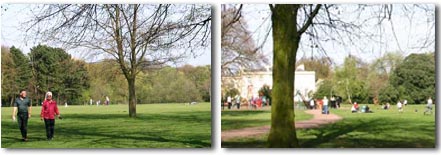
|
| Calderstones Park is one of the city's flagship amenities, but there is too much demand on its space to make it the ideal location for croquet. |
I’m not alone in noting this wasted resource. The Council have introduced a tennis tournament to bring the courts back into service. The site would allow for 16 croquet lawns, far more than I could ever wish for, but four tucked away in a corner would provide all the long-term space I would need. From my biased point of view, this would be a prime site, but convincing anyone in authority is another matter.
The hindrances are both political and practical. Tennis is the top priority for Liverpool’s Leisure Services Directorate, and this area closes down for their annual tournament. In come the A-lister veterans (Navratilova, Ivanisevic et al), up go the temporary grandstands, the security cordon and a cluster of hospitality tents. The Council lays on come-and-try-it games for the kids, and cappuccino bars for the grown-ups. Thousands of feet – all in their unsuitable footwear – trample my newly converted croquet lawns over in the back corner. And who am I, with my little minority sports club, to complain?
What’s more, their exhibition court takes up the flattest, best quality section of the land. My best hope for my four-lawn tournament-quality showcase venue would be the hilliest, slopingest, weediest area. There’s no hope of intrusive maintenance or construction work (at least not during the summer when the tennis celebs come to town), and there’s no chance of getting even a modest clubhouse alongside. Not ever. So cross Calderstones Park off the list.
Sefton Park is Liverpool’s other main area of public land, but has no space suitable for croquet. Walk 500 yards up the road, and there’s another tiny park tucked away. This is Greenbank Park, overlooked by a row of terraced houses to the east and the Halls of Residence for Liverpool University to the south. It’s no surprise that, with a bigger, better park just yards away, no one uses this area. There’s a massive expanse of flat land – 24 potential lawns, if my sums are right – but no shelter, no storage, scant car parking, and poor access. (Having regarded this as my Second Best and then rejected it, it seems that the land is now set aside for Gaelic Football – a high-impact, bruising version of soccer. I feel some solidarity with other minority sports, so am heartened by this news.)
Weighing the virtues of the third-choice site
Clarke Gardens, my third site, lies on the edge of the well-to-do areas of Allerton and Woolton, and is bordered on the other side by the local crematorium and cemetery. The park is dominated by Allerton Hall, a sandstone Georgian mansion, empty since the last of the family died in the 1930s, when its ownership passed to the City Council. Latterly, it’s been converted to accommodate an immense pub-restaurant (which seems to rely for most of its trade on funeral wakes from the crematorium next door).

The rest of the park comprises a woodland nature reserve, an open patch of flat grassland, and a former Pets’ Corner. Rising costs and falling popularity caused the zoo area to close in 1999. The buildings – donkey stables and pigpens – remain, but the whole of Clarke Gardens has seen much happier days. There’s a walled garden, its gates now welded shut and its confines overgrown to the point of dereliction. The huge stable block alongside dates from 1659, though there’s no use for it now. It and the other outlying buildings, birdcages and animal enclosures are boarded up, their entrances chained and padlocked.
All this is an extreme embarrassment for the Council, as they acknowledge. Each structure – the Hall, the walled gardens, the stable, even the iron railings – is Grade 2 listed, preventing future alteration. [Buildings of architectural or historical interest in the UK are subject to a listing process. Grade 1, the highest grade, forbids alteration, either inside or outside, without government approval, which will normally only be granted in the most extreme of circumstances. Grade 2 is slightly less stringent, though alterations must be sympathetic with the original structure. Such alterations are often prohibitively expensive, and their implementation requires specialist legal, as well as architectural, knowledge.] Nobody wants the site, and no one visits the Gardens any more. There’s parking for 80 cars, but a typical sunny Saturday afternoon will see a couple of dog walkers and a deserted park.
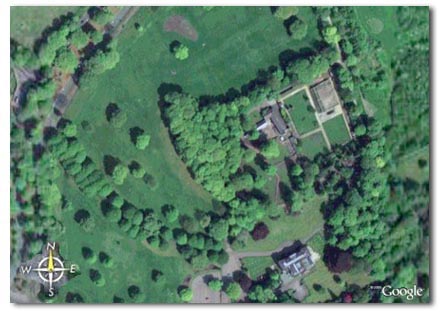
|
| This aerial view of Clarke Gardens reveals a grassed area to the north with enough space for at least six croquet lawns. The walled garden (immediately below) could possibly accommodate a further six. |
Liverpool Croquet Club: the proposal
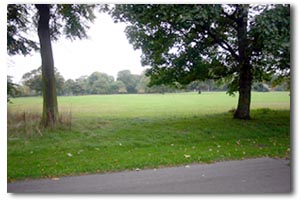
|
| The North lawns provide plenty of space for a start-up club. For long-term use, investment will be needed to improve drainage and the quality of the turf surface. |
Of course, I’ve been there before. I ask the Council for help, and they say no. End of story. So this time, I’ve got to be more persuasive. By December I had a six-page proposal detailing exactly what I had in mind.
Initially, as a start-up club, there’s no need for more than a couple of lawns. Over time, and with more members, I’d expect to bring more of the area into use. I explain the nature of the game. I talk about the demographics of possible members, and the introduction of a schools programme. I’m offering to provide sporting activity for those target groups which the Sports Development team haven’t been able to attract, and – this is the crucial point – I can do it for minimal cost.
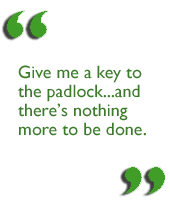
My proposal finds its way to the desk of Derek, the Park Estates Manager in the City Council’s Regeneration Department. We talk on the phone. He’s intrigued, and we agree to meet on-site to discuss the project.
What happens next is slightly hazy. It’s a Thursday morning in the middle of February, and we’re standing by ourselves in Clarke Gardens. I ask to use the park for croquet. He asks me what maintenance I want done on the lawns, and offers to have them ready by June. We shake hands, and that’s it. Could it be that simple?
The secret garden
Well, not entirely. In principle, he’s got something I want (a spare patch of land), and I’ve got something he wants (a plan to use his derelict site). He’s talked about nominal rents, and vaguely hinted at low rates for maintenance, but there are all sorts of issues to iron out.
In April, we arranged another meeting on site. The old zoo area is protected by a 10-foot-high security fence, where I arrived to find Derek with a pair of bolt-cutters, shearing off the old padlock. Inside the fence, everything looks very different. From out on the (prospective) lawns, the stables looked like the perfect clubhouse. From inside, I realise I had been looking at only about a quarter of the building. Downstairs could house the biggest clubhouse in the country (with the obvious exception of Hurlingham), but there’s another floor above. But the laying of four indoor croquet carpets upstairs seems a profligate use of space, and, with restoration costs for the building estimated at about £450,000, it’s certainly beyond the means, or the requirements, of any club.
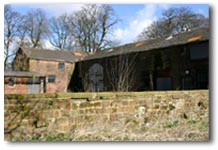
|
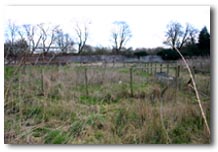
|
| The size and state of repair of this huge sandstone barn dating from 1659 place it far beyond the grasp of any future croquet development, but the wooden block to the left could provide sufficient space for the club, for little initial cost. | Pigs, goats and horses lived in these enclosures until the early 1990s. After decades of abandonment and dereliction, could this site be restored to public use for croquet? |
Alongside, there’s a long, single-storey stone row of outhouses, now almost entirely engulfed in ivy. This is more like it, although there’s still much work to be done on it to make it habitable (windows might be nice). But there’s a third structure here that is much more interesting, for our purposes. It’s a wooden prefabricated building, bought (by Derek) just a couple of years before the zoo animals were evicted. Apparently, it housed several cages of exotic birds. The internal mesh walls are still in place. The floor is inches deep in birdseed, droppings, and feathers. Give me a bucket of soapy water and a spare afternoon, and this could become a palatial clubhouse for a first-year croquet club.
All this is well and good, but the lawns are a hundred yards away. On a typical English summer’s day, that’s going to be a long dash to get out of the rain. But as it turns out, that problem is easily solved, via a gate inside the compound that leads to the walled garden. It’s hard to measure exactly, but there are about 100 by 80 yards’ worth of turf inside there. Do the sums: that’s another six croquet lawns.

Suddenly, the project is in another league: Starting with the prospect of six lawns in a field with a remote hut, we now have, instead, six secure lawns in a walled garden, with adjoining clubhouse, and with the option of increasing to 12 lawns by using the field outside the walls! Is this too good to be true?
A reality check
There’s a downside. Of course there’s a downside. The wilderness that comprises the walled area needs some serious work. For a start, it’s completely overgrown. And secondly, it’s on quite a severe slope. Those in themselves aren’t overriding problems; no matter how many shortcomings a site has, you only need to bulldoze the surface once. Dig it out, terrace it and reseed it, and the lawns are ready for use. Costs have fallen recently for this sort of thing, and in Britain, this six-lawn job is perhaps do-able for as little as £30,000.
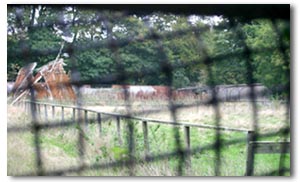
|
| This derelict glasshouse may be beyond repair. The space available within the walled garden is enough for five or six lawns, depending on whether the glasshouse is restored or removed. |
Derek’s proposition
Liverpool City Council owns and operates more parks than they know what to do with. Clarke Gardens is way off the bottom of the priority list. No one at the Council knows what the park is for. Then along comes a stranger – me – and answers the question for them.
There’s no way I can use all the buildings on site, but I’ve enough of an idea to ignite some fresh interest. So, in the short term at least, Derek has proposed the following agreement: I can enlist as many players as I want, to play as often as we wish, on as many lawns as we need. He is happy for me to do that, free of charge. In return, he will reallocate maintenance staff from other areas, to carry out work on the field, getting it up to a playable standard, and doing all the day-to-day mowing. Again, there will be no charge to the croquet club.
At the end of this year, he plans to submit a grant application to finance a feasibility study of around £50,000. (Apparently this is common practice among local authorities seeking assistance for large projects, and is usually viewed with sympathy by the grant-makers.) Assuming that proves fruitful, a report would be prepared, and resubmitted to the same funding body around the middle of 2007. It is likely that this report would include provision for a croquet club within a restored complex of buildings, and it’s likely that the club would have access to the walled garden. What’s uncertain is the long-term use of the listed buildings around the site. The stable block could be converted to provide a garden centre or a craft village. The glasshouse could become the world’s grandest, hottest, and most fragile croquet clubhouse. Or maybe it could be flattened.
Here’s the bottom line
I started this project with no lawns, no members, and no money. I’ve now got free access to a disused football pitch, allowing up to six lawns, with the possibility of an upgrade to a further six deluxe, specially laid lawns within three years. The next step is the recruiting and training of my team of disciples.
My head is swimming with ideas for that next stage, as Derek and I stand ankle-deep in nettles outside what may become the Liverpool Clubhouse. There are players out there – top-flight international players, keen amateur players enjoying the game regularly at home, and thousand upon thousand who don’t yet realise that croquet is their destiny. I’m already mapping out the schedule for play: mid-week sessions for retired people, evenings for fellow thirty-somethings straight out of the office, kids in the afternoons, tournaments at the weekends. Some of you may have stumbled upon this article and want to know more. So, if you’re in Liverpool, and if you think you’d like to learn a great sport and at the same time help establish a club in South Liverpool, just send me an email.
Derek and I leave, and he secures the gate. “Do you want the spare?” he asks, and hands me what was my symbolic target for Phase One. It’s the key to the padlock.
A shorter version of this article has been crafted for publication in the British Croquet Gazette. This article signals the first time a major croquet development project has been subjected to detailed real-time documentation, published worldwide. Literally anything could happen to interrupt or alter the best laid plans of the project’s creator or the city supporting this landmark development. Nevertheless, as of today – in early 2006 – we plan to document the project in these stages: Part One, Revival; Part Two: Club Recruitment; Part Three: Grant Funding and Revenue; Part Four: Construction, Expansion, and Improvement. We dare not title Part Five yet, but it should be the summation of a project which, potentially, sets a new standard as both a major tournament venue and a model for recruitment and coaching in the sport. A reasonable goal for the publication of Part Five would be the year 2010. In the meantime, we’ll let you know how it goes.